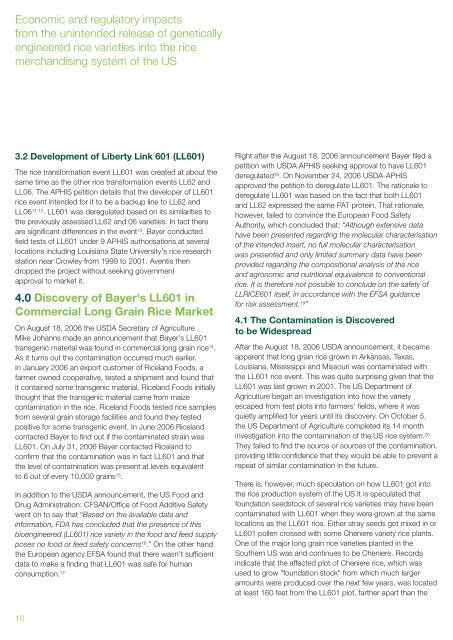Risky Business - Greenpeace
Risky Business - Greenpeace
Risky Business - Greenpeace
You also want an ePaper? Increase the reach of your titles
YUMPU automatically turns print PDFs into web optimized ePapers that Google loves.
Economic and regulatory impacts<br />
from the unintended release of genetically<br />
engineered rice varieties into the rice<br />
merchandising system of the US<br />
3.2 Development of Liberty Link 601 (LL601)<br />
The rice transformation event LL601 was created at about the<br />
same time as the other rice transformation events LL62 and<br />
LL06. The APHIS petition details that the developer of LL601<br />
rice event intended for it to be a backup line to LL62 and<br />
LL06 11 12 . LL601 was deregulated based on its similarities to<br />
the previously assessed LL62 and 06 varieties. In fact there<br />
are significant differences in the event 13 . Bayer conducted<br />
field tests of LL601 under 9 APHIS authorisations at several<br />
locations including Louisiana State University's rice research<br />
station near Crowley from 1999 to 2001. Aventis then<br />
dropped the project without seeking government<br />
approval to market it.<br />
4.0 Discovery of Bayer's LL601 in<br />
Commercial Long Grain Rice Market<br />
On August 18, 2006 the USDA Secretary of Agriculture<br />
Mike Johanns made an announcement that Bayer's LL601<br />
transgenic material was found in commercial long grain rice 14 .<br />
As it turns out the contamination occurred much earlier.<br />
In January 2006 an export customer of Riceland Foods, a<br />
farmer owned cooperative, tested a shipment and found that<br />
it contained some transgenic material. Riceland Foods initially<br />
thought that the transgenic material came from maize<br />
contamination in the rice. Riceland Foods tested rice samples<br />
from several grain storage facilities and found they tested<br />
positive for some transgenic event. In June 2006 Riceland<br />
contacted Bayer to find out if the contaminated strain was<br />
LL601. On July 31, 2006 Bayer contacted Riceland to<br />
confirm that the contamination was in fact LL601 and that<br />
the level of contamination was present at levels equivalent<br />
to 6 out of every 10,000 grains 15 .<br />
In addition to the USDA announcement, the US Food and<br />
Drug Administration: CFSAN/Office of Food Additive Safety<br />
went on to say that “Based on the available data and<br />
information, FDA has concluded that the presence of this<br />
bioengineered (LL601) rice variety in the food and feed supply<br />
poses no food or feed safety concerns 16 .” On the other hand<br />
the European agency EFSA found that there wasn't sufficient<br />
data to make a finding that LL601 was safe for human<br />
consumption. 17<br />
Right after the August 18, 2006 announcement Bayer filed a<br />
petition with USDA APHIS seeking approval to have LL601<br />
deregulated 18 . On November 24, 2006 USDA-APHIS<br />
approved the petition to deregulate LL601. The rationale to<br />
deregulate LL601 was based on the fact that both LL601<br />
and LL62 expressed the same PAT protein. That rationale,<br />
however, failed to convince the European Food Safety<br />
Authority, which concluded that: “Although extensive data<br />
have been presented regarding the molecular characterisation<br />
of the intended insert, no full molecular characterisation<br />
was presented and only limited summary data have been<br />
provided regarding the compositional analysis of the rice<br />
and agronomic and nutritional equivalence to conventional<br />
rice. It is therefore not possible to conclude on the safety of<br />
LLRICE601 itself, in accordance with the EFSA guidance<br />
for risk assessment. 19 ”<br />
4.1 The Contamination is Discovered<br />
to be Widespread<br />
After the August 18, 2006 USDA announcement, it became<br />
apparent that long grain rice grown in Arkansas, Texas,<br />
Louisiana, Mississippi and Missouri was contaminated with<br />
the LL601 rice event. This was quite surprising given that the<br />
LL601 was last grown in 2001. The US Department of<br />
Agriculture began an investigation into how the variety<br />
escaped from test plots into farmers' fields, where it was<br />
quietly amplified for years until its discovery. On October 5,<br />
the US Department of Agriculture completed its 14 month<br />
investigation into the contamination of the US rice system. 20<br />
They failed to find the source or sources of the contamination,<br />
providing little confidence that they would be able to prevent a<br />
repeat of similar contamination in the future.<br />
There is, however, much speculation on how LL601 got into<br />
the rice production system of the US It is speculated that<br />
foundation seedstock of several rice varieties may have been<br />
contaminated with LL601 when they were grown at the same<br />
locations as the LL601 rice. Either stray seeds got mixed in or<br />
LL601 pollen crossed with some Cheniere variety rice plants.<br />
One of the major long grain rice varieties planted in the<br />
Southern US was and continues to be Cheniere. Records<br />
indicate that the affected plot of Cheniere rice, which was<br />
used to grow "foundation stock" from which much larger<br />
amounts were produced over the next few years, was located<br />
at least 160 feet from the LL601 plot, farther apart than the<br />
10

















